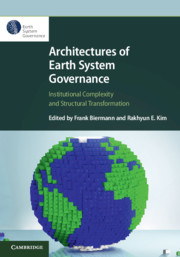Book contents
- Architectures of Earth System Governance
- Series page
- Architectures of Earth System Governance
- Copyright page
- Contents
- Contributors
- Acknowledgements
- 1 Architectures of Earth System Governance
- Part I The Building Blocks
- Part II Core Structural Features
- Part III Policy Responses
- 9 Policy Integration
- 10 Interplay Management
- 11 Orchestration
- 12 Governance through Global Goals
- 13 Hierarchization
- Part IV Future Directions
- Glossary
- Index
- References
10 - Interplay Management
from Part III - Policy Responses
Published online by Cambridge University Press: 17 April 2020
- Architectures of Earth System Governance
- Series page
- Architectures of Earth System Governance
- Copyright page
- Contents
- Contributors
- Acknowledgements
- 1 Architectures of Earth System Governance
- Part I The Building Blocks
- Part II Core Structural Features
- Part III Policy Responses
- 9 Policy Integration
- 10 Interplay Management
- 11 Orchestration
- 12 Governance through Global Goals
- 13 Hierarchization
- Part IV Future Directions
- Glossary
- Index
- References
Summary
Interplay management involves deliberate efforts by one or more actors to improve the interplay of institutions set up for earth system governance. This chapter synthesizes two decades of conceptual and empirical research on the conditions that influence the conduciveness of interplay management to earth system governance. Those conditions concern the agency and the means of management, notably whether interplay management proceeds by means of coordination or adaptation, as well as the compatibility of the policy objectives pursued. Agents of interplay management are states, intergovernmental organizations and industry- or civil-society groups, seeking to mobilize assets such as material resources, expertise or legitimacy held by one institution to promote objectives pursued under another. Means employed are frequently variants of unilateral adaptation to norms and programmes undertaken in other institutions, rather than explicit coordination involving joint decision-making. Cross-institutional coordination has obvious advantages and is particularly valuable when the institutions govern highly interdependent activities or can bring to bear complementary capacities. With clearly competitive elements present, adaptation has the advantage of triggering less turf-sensitive resistance.
Keywords
- Type
- Chapter
- Information
- Architectures of Earth System GovernanceInstitutional Complexity and Structural Transformation, pp. 207 - 232Publisher: Cambridge University PressPrint publication year: 2020
References
- 6
- Cited by

